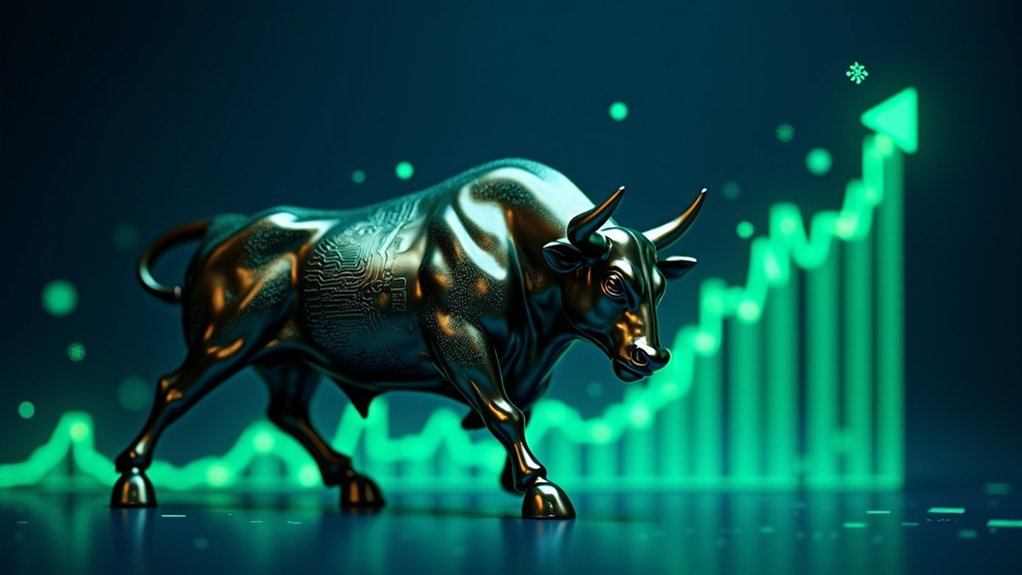A bull market in cryptocurrency occurs when prices climb at least 20% from recent lows and continue pushing higher. It’s a self-reinforcing cycle of enthusiasm where investors exhibit greed due to profit potential. Like a financial avalanche, these markets build momentum over months or years, creating a pattern where small dips recover quickly. Trading volumes explode, social media fills with rocket emojis, and supply tightens as holders resist selling. The crypto rollercoaster has more thrilling drops and climbs ahead.
A bull market in cryptocurrency isn’t just some random Wall Street jargon—it’s the rocket fuel that sends digital asset prices soaring.
When crypto enters a bull phase, prices climb at least 20% from recent lows and keep pushing higher.
Investors get greedy.
They smell profit.
And nobody wants to be the sucker who missed out while their neighbor’s college dropout kid just bought a Lamborghini with Ethereum gains.
These bullish periods don’t happen overnight.
Bull markets are marathons, not sprints—they build momentum over time like a financial avalanche gaining speed.
They stretch for months, sometimes years, creating a self-reinforcing cycle of enthusiasm and profit-taking.
Remember 2017?
Or 2021?
Classic bull runs that had even your technophobic grandparents asking about Bitcoin.
The psychology is pretty simple: prices go up, people notice, more people buy in, prices climb higher.
Rinse and repeat.
During these surges, trading volumes explode.
Social media lights up with rocket emojis.
Celebrity endorsements suddenly appear everywhere.
Even bad news barely dents the upward momentum—small dips quickly recover as the “buy the dip” mentality kicks in.
It’s mass psychology in action, and it’s fascinating to watch.
Bull markets don’t exist in a vacuum.
They often align with positive economic conditions—low unemployment, growing corporate profits, and general optimism about the future.
When people feel financially secure, they’re more willing to gamble on speculative assets.
Makes sense, right?
The latest crypto bull run is expected to see lengthening cycles extend into late 2026.
What’s particularly interesting about crypto bull markets is how they transform supply and demand dynamics.
As prices climb, holders become less willing to sell, creating scarcity that pushes values even higher.
Meanwhile, demand skyrockets as FOMO kicks in.
The historical origins of the term “bull” date back to the 17th century, symbolizing upward market movements through the animal’s upward thrusting horns.
Basic economics at work.
During these periods, tweets from influential figures claiming assets will go “To the moon” can dramatically accelerate market movements.
Eventually, all bull markets end.
Something shifts—regulation changes, negative news breaks, or the market simply runs out of new buyers.
But while they last?
These periods create both legitimate wealth and unsustainable bubbles.
That’s just how it works.
Crypto bull markets: exhilarating, profitable, and ultimately temporary.
Frequently Asked Questions
How Do I Identify Entry and Exit Points in Crypto Bull Markets?
Successful traders identify entry points by watching for breakouts above resistance levels, volume spikes, and technical indicators like RSI climbing above 30 or golden crosses.
Exit points? They’re trickier. Look for extreme RSI readings above 70, declining volume during price advances, and bearish divergences between price and momentum indicators.
Market hype hitting fever pitch? Classic sell signal.
Smart money sets profit targets and uses trailing stops. The rest? They’re left holding bags.
Markets don’t care about feelings.
Can Bull Markets Be Predicted Through Specific Technical Indicators?
Technical indicators can help predict crypto bull markets, but they’re no crystal ball. Moving averages, RSI above 50, and MACD crossovers often signal upward momentum. Volume trends matter too. The Fear and Greed Index sometimes telegraphs sentiment shifts before prices explode.
Problem is, these tools frequently generate false signals. Crypto’s wild volatility makes technicals unreliable on their own. External factors—regulatory news, macroeconomic shifts—can blindside even the best technical analysis.
Nothing’s guaranteed in crypto. Never is.
What Are the Typical Pitfalls Investors Face During Cryptocurrency Bull Runs?
Investors get trapped in multiple pitfalls during crypto bull runs. Overconfidence leads to reckless speculation beyond fundamental values.
Risk management goes out the window—no diversification, no stop-losses. Just pure FOMO. Emotional bias keeps them holding too long. No exit strategy? Big mistake.
Market manipulation thrives when everyone’s euphoric. Whales dump, retail investors get crushed. Social media hype clouds judgment. Everyone thinks they’re a genius in a bull market. Until they’re not.
How Do Stablecoins Perform During Bull Markets?
Stablecoins actually thrive during bull markets.
Their supply typically increases—USDT and USDC surged 59% year-on-year to $114 billion by March 2025.
Funny enough, they’re both indicators and facilitators.
When stablecoin supply grows, it often precedes Bitcoin rallies.
Their market cap hit $235 billion in mid-2025.
Investors hoard them to deploy capital quickly when opportunities arise.
But their dominance percentage drops as other cryptos outperform.
The perfect sidekick, really.
Does Institutional Investment Always Precede Crypto Bull Markets?
No, institutional investment doesn’t always precede crypto bull markets. Sometimes it’s the other way around.
Institutions often jump in after prices start climbing—classic FOMO behavior, just with bigger wallets.
Retail investors and technological events like Bitcoin halvings frequently kick things off first.
Sure, institutional money validates the market and can sustain the momentum, but they’re not always the trendsetter.
Sometimes they’re following the crowd, just like everyone else. Smart money isn’t always early money.









